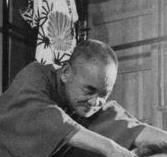Difference between revisions of "Seiu Ito"
| Line 14: | Line 14: | ||
==Alternate Names== | ==Alternate Names== | ||
[https://smpedia.com/index.php?title=伊藤晴雨 伊藤晴雨](Japanese), Hajime Ito (伊藤一, real name) | [https://smpedia.com/index.php?title=伊藤晴雨 伊藤晴雨](Japanese), Hajime Ito (伊藤一, real name) | ||
| + | |||
| + | ==Alternate Names== | ||
| + | [https://smpedia.com/index.php?title=伊藤晴雨 伊藤晴雨](Japanese), Hajime Ito (伊藤一, real name) | ||
| + | |||
| + | == Summary == | ||
| + | Born in 1882, '''Ito''' was strongly attracted to scenes of torture in stories and theater plays from an early age, and he produced a large body of paintings, drawings and photographs depicting scenes of torture and kinbaku, often using his wife or mistress as his model. | ||
| + | |||
| + | By the 1910s, '''Ito''' was a newspaper illustrator and then a theater critic. He later became the head of the Performing Arts section as well as the main illustrator for the <i>Yomiuri News</i>. At the beginning of the Taisho period (1912-1926), he met [[Kaneyo Sasaki]] (Oyou) and [[Kise Sahara]], two women who would eventually become his models. He deepened his study of torture art and photography, and in the closing years of Taisho, he rode the wave of the <i>eroguro</i> movement and attracted attention as a “painter of perversion”. In 1928, he published his first kinbaku-related book (<i>Seme no Kenkyu – Torment Research</i>), which was soon after banned by the authorities. | ||
| + | |||
| + | During the Taisho period, he established theater groups whose plays centered on torture scenes. Before World War II, he published a large number of collections of graphic works through editor Suikodo Shoten. Ito was at the height of his career, but this was interrupted by the war. After the war, he worked as a writer in magazines such as [[Ningen Tankyu]], [[Kitan Club]] and [[Fuzoku Soshi]]. In addition, he organized frequent photo sessions, and the resulting photos can be seen as “photos in the Seiyu way” in magazines such as [[Fuzoku Soshi]], [[Fuzoku Kitan]] and [[Uramado]]. In 1953, he started the Seme no Gekidan (Torture Theater Group) which performed at Ichikawa Suzumoto theater in Tokyo and others. | ||
| + | |||
| + | He was also an historian and his lifelong research culminated in the book <i>Iroha Biki -- Edo to Tokyo Fuzoku Yashi</i> which details the tools and crafts of old Tokyo. | ||
Revision as of 14:11, 22 November 2023
Ito (伊藤) family name, Seiu (晴雨) first name, (1882-1961)
Activities
Painter, Writer, Kinbakushi
Alternate Names
伊藤晴雨(Japanese), Hajime Ito (伊藤一, real name)
Alternate Names
伊藤晴雨(Japanese), Hajime Ito (伊藤一, real name)
Summary
Born in 1882, Ito was strongly attracted to scenes of torture in stories and theater plays from an early age, and he produced a large body of paintings, drawings and photographs depicting scenes of torture and kinbaku, often using his wife or mistress as his model.
By the 1910s, Ito was a newspaper illustrator and then a theater critic. He later became the head of the Performing Arts section as well as the main illustrator for the Yomiuri News. At the beginning of the Taisho period (1912-1926), he met Kaneyo Sasaki (Oyou) and Kise Sahara, two women who would eventually become his models. He deepened his study of torture art and photography, and in the closing years of Taisho, he rode the wave of the eroguro movement and attracted attention as a “painter of perversion”. In 1928, he published his first kinbaku-related book (Seme no Kenkyu – Torment Research), which was soon after banned by the authorities.
During the Taisho period, he established theater groups whose plays centered on torture scenes. Before World War II, he published a large number of collections of graphic works through editor Suikodo Shoten. Ito was at the height of his career, but this was interrupted by the war. After the war, he worked as a writer in magazines such as Ningen Tankyu, Kitan Club and Fuzoku Soshi. In addition, he organized frequent photo sessions, and the resulting photos can be seen as “photos in the Seiyu way” in magazines such as Fuzoku Soshi, Fuzoku Kitan and Uramado. In 1953, he started the Seme no Gekidan (Torture Theater Group) which performed at Ichikawa Suzumoto theater in Tokyo and others.
He was also an historian and his lifelong research culminated in the book Iroha Biki -- Edo to Tokyo Fuzoku Yashi which details the tools and crafts of old Tokyo.
